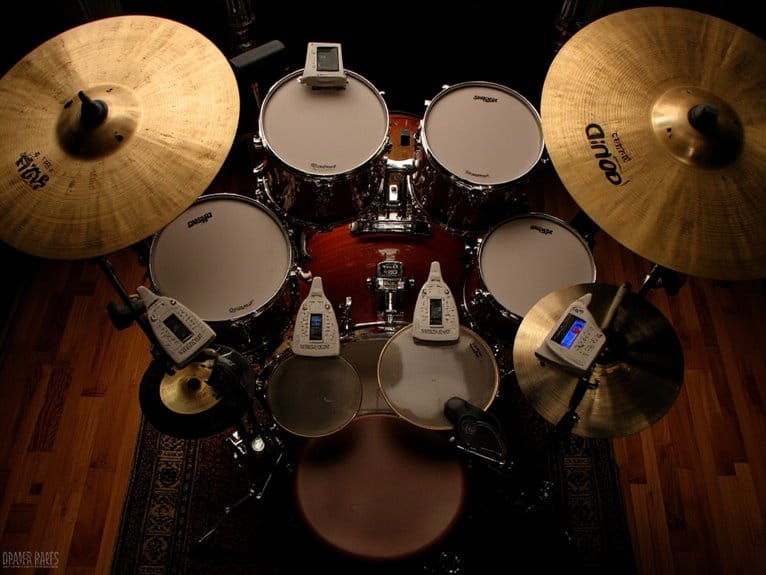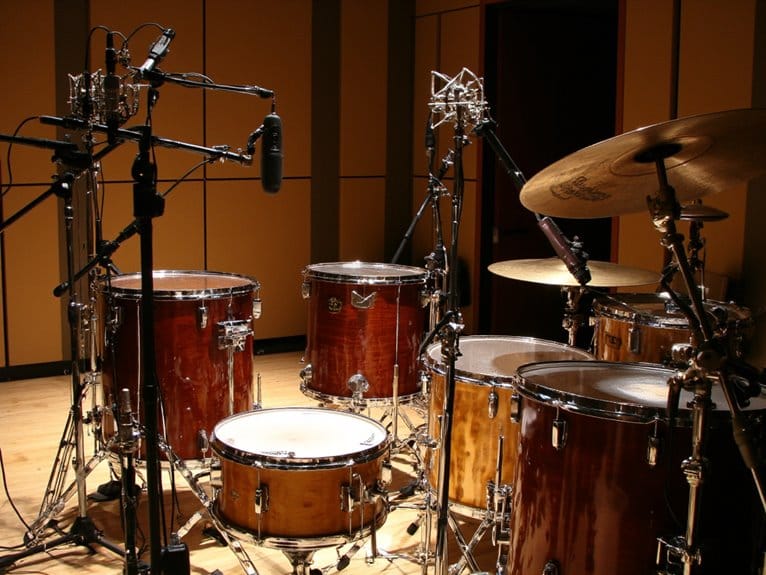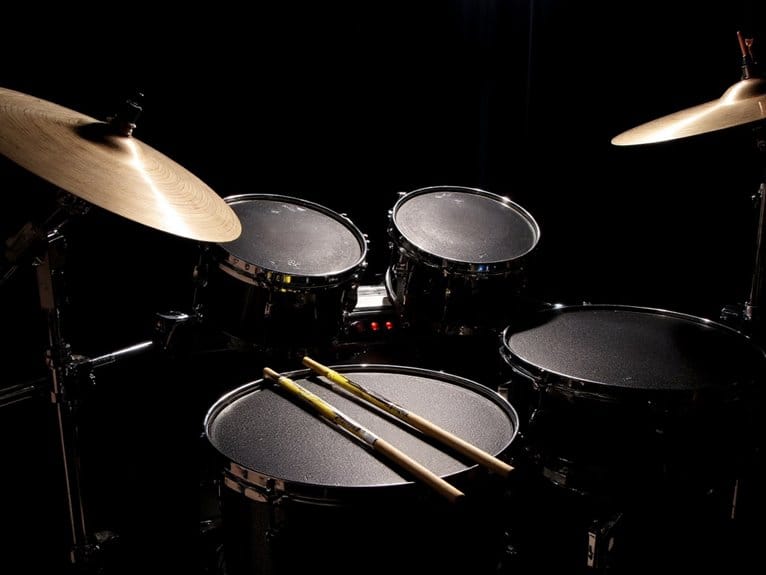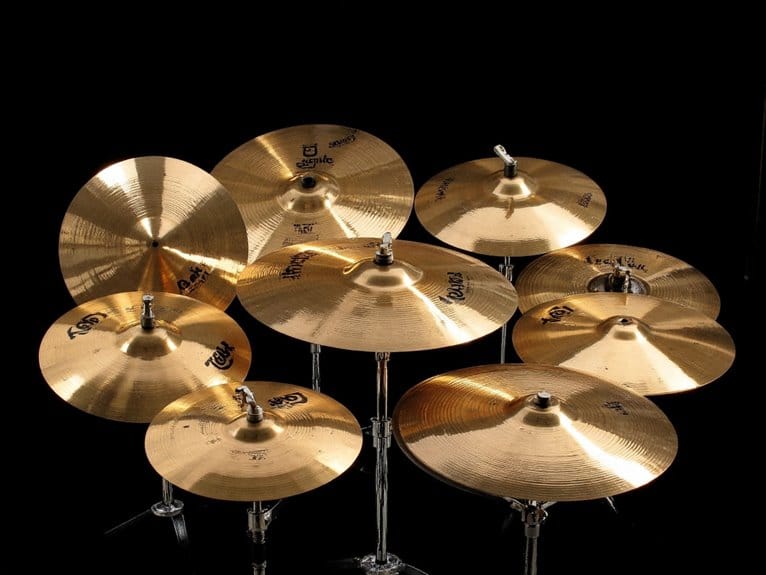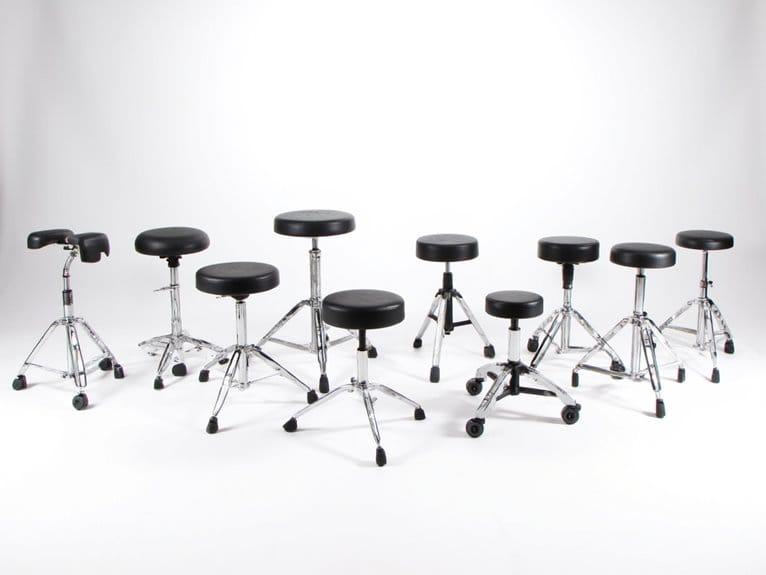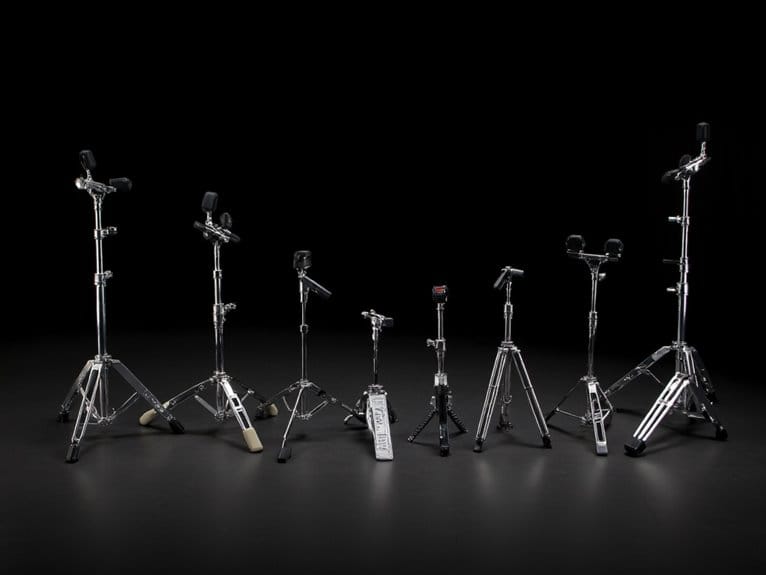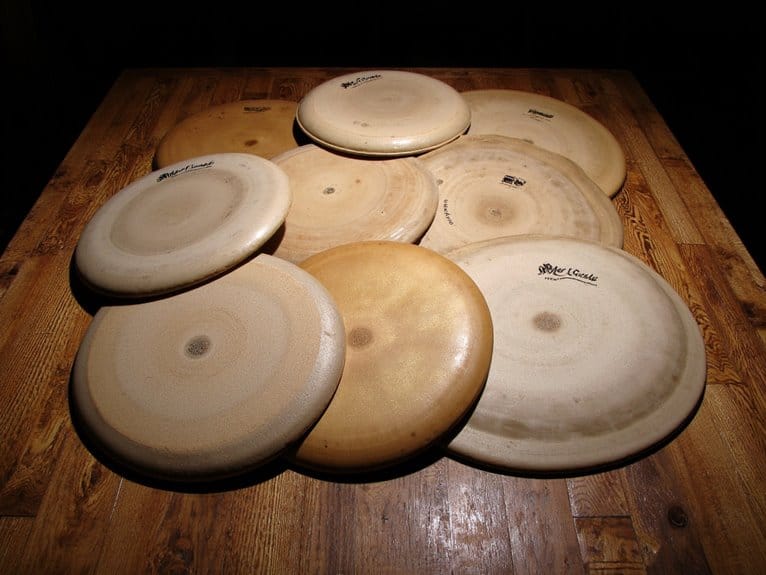10 Best Drum Metronomes – Keep Perfect Time Every Beat
After testing dozens of drum metronomes, I’ve found the Sondery Digital Metronome leads with its 10-hour rechargeable battery, vocal counting features, and intuitive rotary dial covering 40-208 BPM. The SDREAM Digital offers excellent human English beats with Type-C charging, while the Korg MA-2 provides exceptional battery life and visual beat indicators. For traditionalists, the Donner Mechanical delivers loud woodblock sounds without power concerns. Each serves different drumming styles, and understanding their specific capabilities will help you choose the perfect timing companion.
We are supported by our audience. When you purchase through links on our site, we may earn an affiliate commission, at no extra cost for you. Learn more.
Notable Insights
- Digital metronomes like Sondery and SDREAM offer 10+ rhythm patterns with vocal counting features specifically beneficial for drummers.
- Most quality drum metronomes cover 40-208 BPM ranges with tap tempo functions for quick adjustments during practice sessions.
- Rechargeable models provide 8-10 hours continuous use while mechanical options eliminate battery concerns through traditional wind-up mechanisms.
- Visual beat indicators and backlit displays enhance rhythm comprehension and visibility during low-light drumming practice environments.
- Combination tuner-metronomes like Korg TM60BK offer dual functionality with extended battery life up to 130 hours for versatile practice.
Sondery Digital Metronome Rechargeable with Timer Function for All Instruments
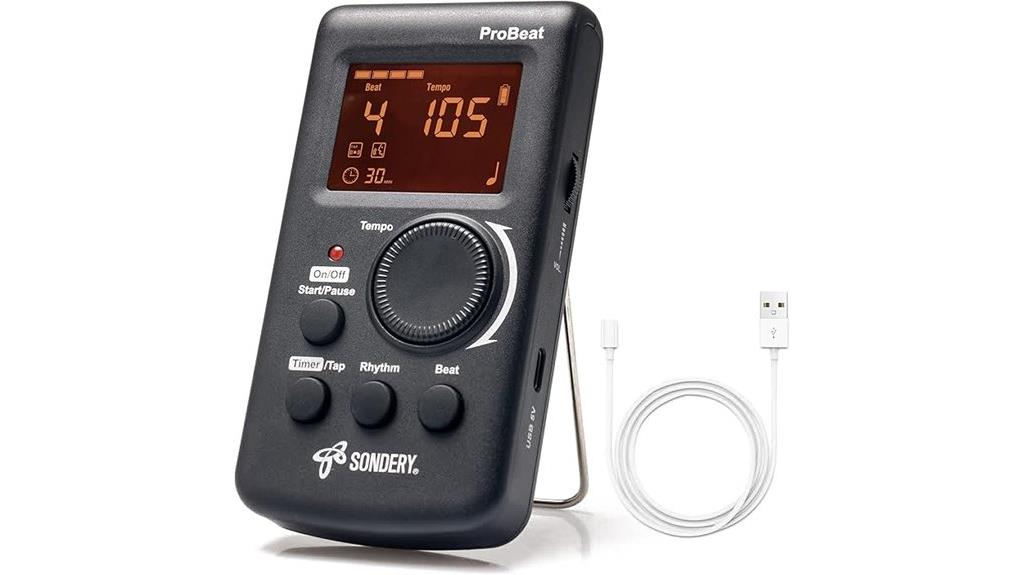
If you’re a drummer seeking a versatile practice companion that won’t drain your wallet, the Sondery Digital Metronome stands out as Amazon’s #1-ranked metronome for good reason. This rechargeable unit delivers 10 hours of continuous use, features vocal counting alongside three distinct digital sounds, and offers 10 beat patterns with tempo ranging from 40 to 208 bpm through its intuitive rotary dial. You’ll appreciate the tap function that captures your preferred tempo with just two taps, while the built-in timer lets you structure practice sessions at 15, 30, 45, or 60-minute intervals for disciplined training routines.
Best For: Musicians of all levels who need a reliable, feature-rich metronome for structured practice sessions across various instruments including piano, guitar, and drums.
Pros:
- Long 10-hour battery life with quick 3-hour charging time eliminates frequent recharging interruptions
- Vocal counting feature combined with multiple sound options and beat patterns provides versatile practice support
- Built-in timer function with preset intervals helps establish disciplined practice routines and time management
Cons:
- Volume may not be loud enough for certain instruments or noisy practice environments
- Charging compatibility issues reported with some USB cables other than the included one
- Limited maximum volume output may require close proximity during use
Digital Rechargeable LCD Electronic Metronome for Piano, Guitar, Violin

When you’re searching for a metronome that seamlessly bridges traditional functionality with modern convenience, the SDREAM Digital Rechargeable LCD Electronic Metronome stands out as an exceptionally versatile choice that’ll serve drummers across all skill levels. This pyramid-shaped device combines classic aesthetics with modern precision, offering two distinct voice options including human English beats and electronic sounds across 10 extensive rhythm patterns. You’ll appreciate the quick-adjust buttons that span 40 to 208 beats per minute, while the Type-C charging provides over eight hours of continuous operation. The compact, palm-sized design weighs just 0.29 pounds, and the included 3.5mm headphone jack guarantees you can practice without disturbing others during extended sessions.
Best For: Musicians of all skill levels who need a portable, versatile metronome with modern features like rechargeable battery and headphone connectivity for practicing piano, guitar, violin, and other instruments.
Pros:
- Long-lasting Type-C rechargeable battery provides over 8 hours of operation
- Compact and lightweight design (0.29lb) with headphone jack for silent practice
- Wide tempo range (40-208 BPM) with 10 rhythm patterns and dual voice options
Cons:
- Limited to 10 rhythm patterns which may not cover all musical styles
- Pyramid shape may be less stable than flat-based designs during use
- No mention of volume control for the built-in speaker
Ueteto Digital Metronome with Timer and English Vocal Counting
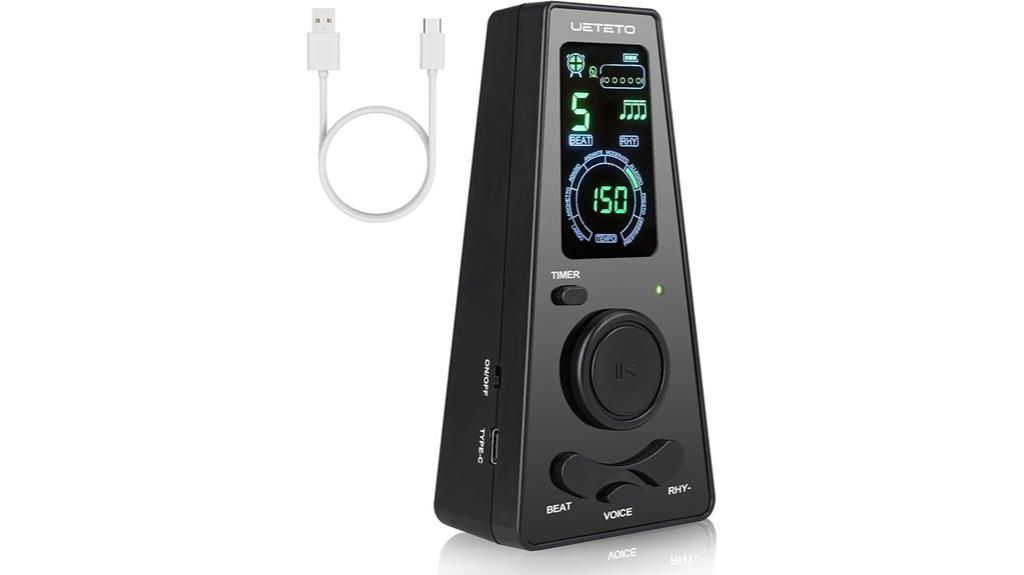
The Ueteto Digital Metronome consistently stands out as an exceptional choice for drummers who frequently practice with vintage or acoustic kits, thanks to its traditional upright design that seamlessly blends nostalgic aesthetics with modern digital functionality. You’ll appreciate its 40-208 bpm range, which covers everything from ballads to blast beats, while the English vocal counting feature helps you internalize complex rhythmic patterns without constantly watching the display. The timer settings at 15, 30, 45, and 60-minute intervals keep your practice sessions focused, and I’ve found the USB-C charging capability particularly convenient since you won’t constantly replace batteries during intensive rehearsal periods.
Best For: Drummers and musicians who want a reliable digital metronome with traditional aesthetics, English vocal counting, and flexible power options for both acoustic and vintage instrument practice sessions.
Pros:
- Wide tempo range (40-208 bpm) with English vocal counting feature that helps internalize rhythmic patterns without visual dependence
- Dual power options (USB-C charging and AAA batteries) with memory retention during power interruptions for uninterrupted practice
- Traditional upright design with modern LCD display that complements vintage instruments while offering adjustable volume and headphone output for silent practice
Cons:
- Some users report timing accuracy issues and tempo variations at specific BPM settings compared to higher-end models
- Initial volume levels may require adjustment, with some users needing DIY modifications to achieve preferred sound characteristics
- Limited customization options for modifying sound characteristics and rhythm pattern flexibility
Sondery Digital Metronome Rechargeable with Timer Function for All Instruments
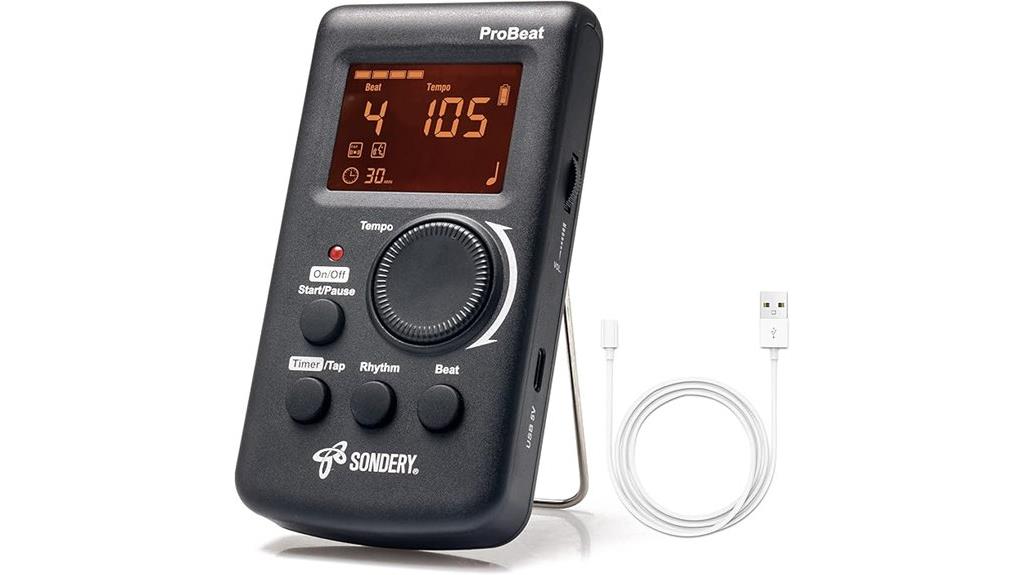
Versatile musicians who switch between multiple instruments will find their practice companion in the Sondery Digital Metronome, a rechargeable powerhouse that I’ve discovered addresses the common frustration of carrying separate timing devices for piano, guitar, and drum sessions. You’ll appreciate the straightforward button controls that let you dial in tempo from 40 to 208 bpm, while the color screen eliminates squinting during practice sessions. The 10-hour battery life means fewer interruptions, though I’ve noticed some users wish the volume packed more punch for drums. With its 4.6-star Amazon ranking and vocal counting feature, this compact 4.3-ounce unit delivers reliable timing across instruments.
Best For: Musicians who practice multiple instruments and need a reliable, portable metronome with long battery life and clear visual display.
Pros:
- 10-hour rechargeable battery eliminates frequent charging interruptions during practice sessions
- Versatile functionality with vocal counting, 10 beat patterns, and tempo range from 40-208 bpm suitable for all instruments
- Compact design with color screen and kickstand makes it easy to read and position during practice
Cons:
- Volume may not be loud enough for drums and other louder instruments
- Some users experience charging issues with certain cables despite included USB-C cable
- Limited timer options with only four preset intervals (15, 30, 45, and 60 minutes)
Korg MA-2 Digital Metronome for Orchestral Instruments – Blue/Black
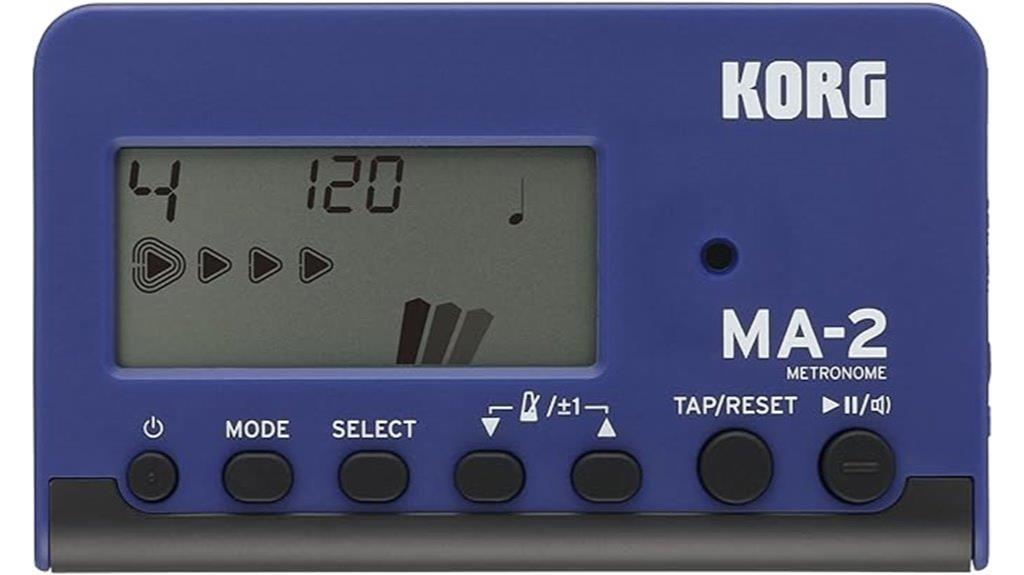
Budget-conscious drummers who need reliable timekeeping without breaking the bank will find their perfect match in the Korg MA-2, a compact digital metronome that delivers orchestral-grade precision at an accessible price point. You’ll appreciate the 30% larger display with beat visuals, which makes tracking tempo changes effortless during practice sessions, while the electronic buzzer provides clear, audible clicks that cut through drum noise effectively. The three tempo settings—Pendulum, Full Step, and Tap Tempo—offer flexibility for different practice scenarios, and you can select from time signatures ranging 0–9 beats with eight rhythm types for extensive musical versatility.
Best For: Budget-conscious drummers and musicians who need a reliable, portable metronome with clear visual and audio cues for practice sessions.
Pros:
- 30% larger display with beat visuals makes tempo tracking easy during practice
- Exceptional battery life of up to 400 hours on alkaline batteries with low battery indicator
- Versatile functionality with three tempo settings, multiple time signatures (0-9 beats), and eight rhythm types
Cons:
- Mixed reviews indicate the buzzer tone quality may not meet everyone’s preferences
- Extremely lightweight at 0.003 ounces might feel less durable than heavier alternatives
- Basic feature set may be limiting for advanced musicians seeking more sophisticated metronome functions
Tama RW200 Rhythm Watch – Drummer S Metronome
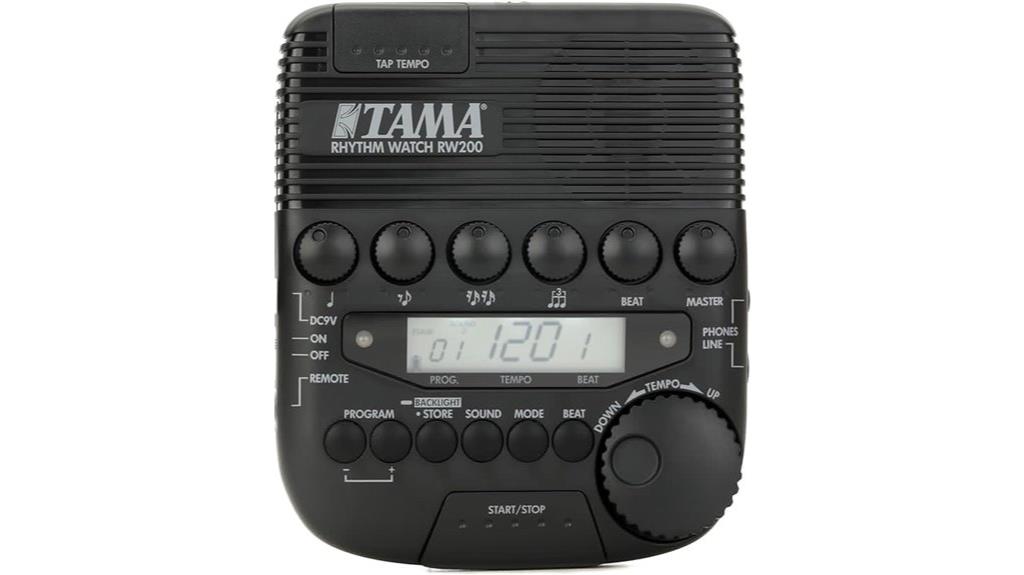
Serious drummers who demand precise timing control will find the Tama RW200 Rhythm Watch delivers exceptional programmability through its 30 memory settings, nine different beat divisions, and extensive 35-250 BPM range that covers everything from slow ballads to lightning-fast metal tracks. You’ll appreciate the backlit display‘s visibility during dimly lit performances, while beat division volume controls let you customize which subdivisions you actually hear during practice. The unit’s synthetic construction keeps weight down to just 12 ounces, though some users report durability concerns after several months of regular use, which honestly isn’t surprising given the electronic components packed into this compact device.
Best For: Serious drummers who need precise timing control with programmable features for solo practice, band rehearsals, and live performances across a wide range of musical styles.
Pros:
- Highly programmable with 30 memory settings, 9 beat divisions, and customizable volume controls for subdivisions
- Wide BPM range (35-250) covers everything from slow ballads to fast metal tracks
- Backlit display provides excellent visibility during dimly lit performances and practice sessions
Cons:
- Durability concerns with some units failing after several months of regular use
- Sound quality issues reported by some users
- Potential difficulties with warranty claims and customer support
Korg TM60BK Tuner Metronome, Black
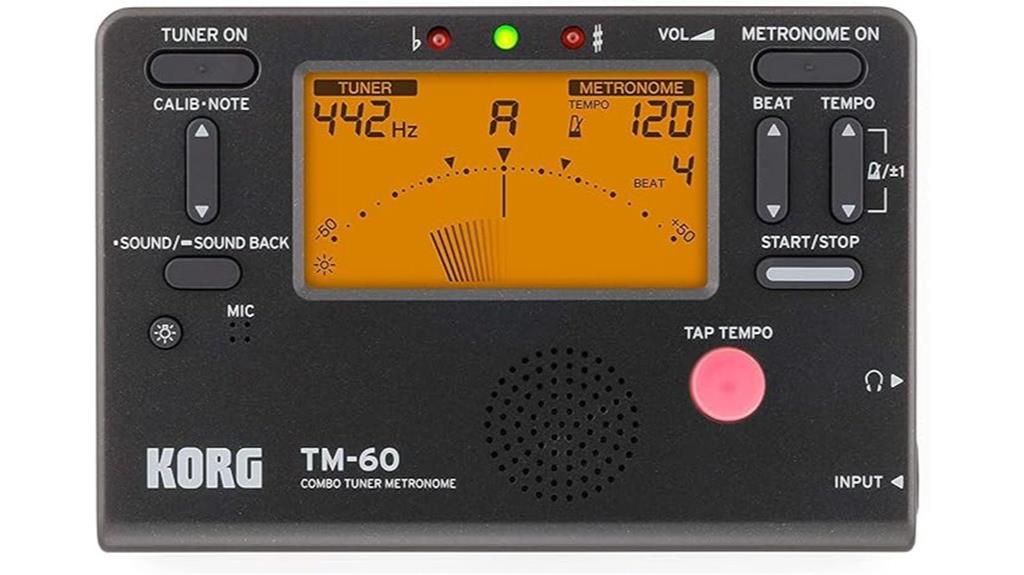
When you need both precise tuning and reliable rhythm guidance in a single device, the Korg TM60BK Tuner Metronome delivers exceptional functionality that makes it particularly valuable for drummers who also handle melodic instruments or work closely with other musicians during practice sessions. You’ll appreciate the simultaneous tuner and metronome operation, allowing you to maintain steady tempo while helping bandmates stay in tune. The 15 rhythm variations and 30-252 BPM range accommodate everything from ballads to blazing metal tracks, while the large backlit LCD guarantees clear visibility in dimly lit practice spaces. With 130-hour battery life and memory backup that retains your settings, this compact 4.6-ounce unit won’t let you down mid-practice.
Best For: Musicians who need both precise tuning and rhythm guidance in one device, particularly those who play multiple instruments or work in band settings where coordinated pitch and timing are essential.
Pros:
- Simultaneous tuner and metronome operation allows you to work on pitch accuracy and rhythm at the same time
- Exceptional battery life of 130 hours with memory backup that retains settings when powered off
- Wide range of connectivity options including built-in microphone, 1/4″ instrument cable, and contact mic for versatile use
Cons:
- Limited sound options for metronome timing may not suit all musical preferences
- Plastic casing can feel slippery during handling
- Electronic metronome tone, while less annoying than typical beeps, still lacks the warmth of acoustic click sounds
Ueteto Mechanical Metronome Black/Loud Sound Piano Drum Violin Guitar
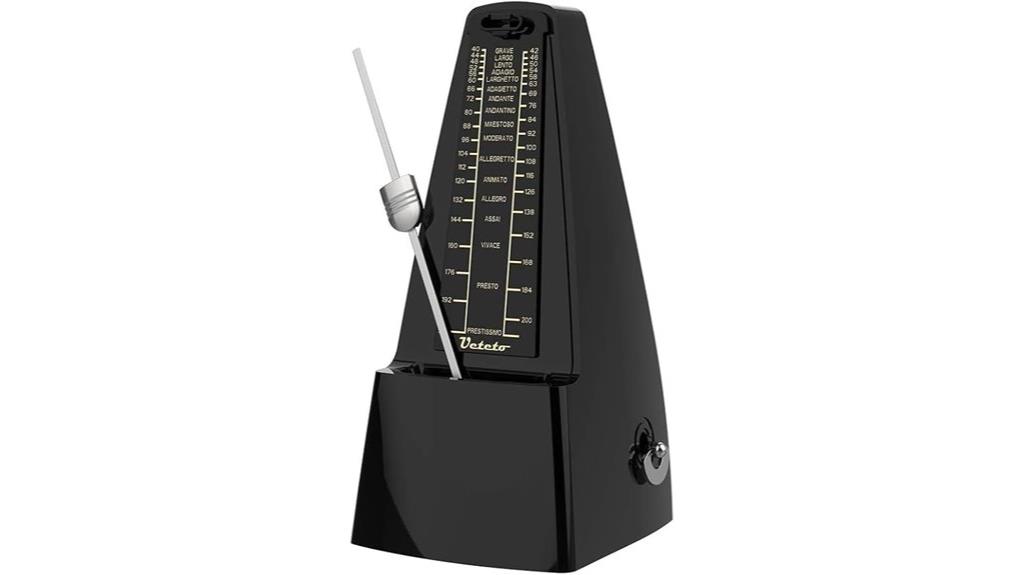
The Ueteto Mechanical Metronome stands out as an excellent choice for drummers who prefer traditional, battery-free practice tools, since its wind-up mechanism delivers consistent performance without the hassle of dead batteries or power cords. You’ll appreciate its impressive tempo range of 40-208 bpm, which covers everything from slow ballads to blazing metal tracks, while the beat selections of 0, 2, 3, 4, and 6 accommodate various time signatures you’ll encounter in drumming. The audible click and bell ring provide clear rhythmic guidance that cuts through drum noise effectively, and each wind delivers approximately 18 minutes of continuous operation.
Best For: Musicians of all skill levels, especially drummers and beginners who want a reliable, traditional metronome that doesn’t require batteries or power cords.
Pros:
- Wind-up mechanism provides 18 minutes of continuous operation without batteries or power requirements
- Wide tempo range of 40-208 bpm covers everything from slow ballads to fast-paced music across multiple instruments
- Loud, clear audible click and bell ring effectively cut through instrument noise for reliable rhythm guidance
Cons:
- Requires manual rewinding every 18 minutes during longer practice sessions
- Mechanical design may be less precise than digital metronomes over extended use
- Limited to basic metronome functions without advanced features like programmable rhythms or visual displays
LEKATO Digital Metronome (M65) for Piano, Guitar, Flute, Violin, Drum
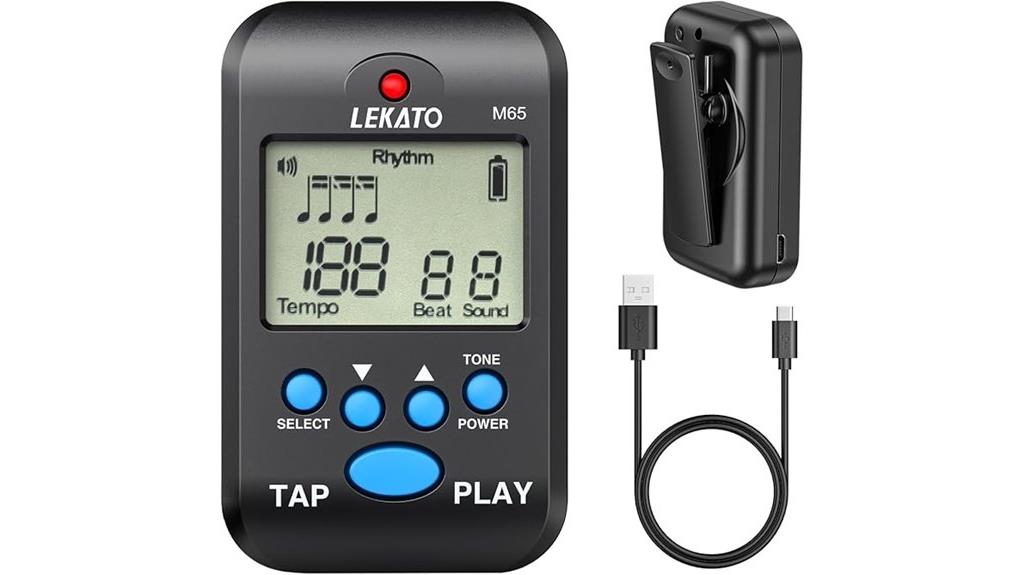
Drummers who need a budget-friendly metronome that won’t break the bank will find the LEKATO Digital Metronome (M65) offers impressive versatility for its price point, though I’ll admit it’s not specifically designed for drum applications. This compact device, weighing just 2.68 ounces, delivers adjustable volume with stereo headphone output for silent practice sessions. You’ll get 4-5 hours of battery life, tempo settings from 30-280 bpm, and ten different beat sounds, including human voice options. While some users note that the sound quality could use improvement, the TAP function and diverse rhythms make it suitable for basic drumming practice.
Best For: Budget-conscious musicians and beginners who need a versatile, portable metronome for various instruments including drums, piano, guitar, flute, and violin.
Pros:
- Rechargeable battery provides 4-5 hours of use and is more energy-efficient than mechanical metronomes
- Compact and lightweight design (2.68 oz) with clip and lanyard for easy portability
- Wide tempo range (30-280 bpm) with TAP function and headphone jack for silent practice
Cons:
- Sound quality and metronome tone options could be improved for better auditory comfort
- Not specifically designed for drum applications despite being marketed for drummers
- Instructions lack clarity according to some user feedback
Donner Mechanical Metronome for Piano Guitar Drum Violin (DPM-1)

Musicians seeking a traditional metronome experience without battery dependencies will find the Donner Mechanical Metronome (DPM-1) delivers reliable tempo guidance across multiple instruments, from piano and guitar to drums and violin. This pyramid-shaped device offers 40-208 BPM range with 1% tolerance, featuring steel movement mechanisms that’ll outlast your practice motivation. You’ll appreciate the loud wood block sound with five-position bell settings, perfect for cutting through drum practice sessions without requiring amplification. The wind-up spring mechanism eliminates battery concerns, while its 1.32-pound construction balances portability with stability during intense playing.
Best For: Musicians who prefer traditional mechanical metronomes and need loud, clear tempo guidance for acoustic instruments without relying on batteries or electronic components.
Pros:
- Wind-up spring mechanism eliminates battery dependency and provides reliable operation
- Loud wood block sound with adjustable bell settings cuts through practice sessions without amplification
- Durable steel movement construction with classic pyramid design offers long-lasting performance
Cons:
- Some users report calibration accuracy issues over time
- Mixed customer service experiences when addressing product defects
- Limited to basic tempo functions compared to feature-rich electronic alternatives
Factors to Consider When Choosing a Drum Metronome
When I’m helping drummers select the perfect metronome, I’ve found that five critical factors consistently determine whether you’ll love or regret your purchase. These considerations—volume and sound quality, tempo range capabilities, battery life duration, display visibility features, and durability—will make or break your practice sessions, especially when you’re competing against the natural volume of acoustic drums. I’ll walk you through each factor so you can make an informed decision that matches your specific drumming needs, practice environment, and budget constraints.
Volume and Sound Quality
Two critical aspects I’ve learned can make or break your metronome experience: volume capability and sound quality, which directly determine whether you’ll actually hear the click over your drum kit and stick with your practice routine. I’ve found that adjustable volume settings are essential, allowing you to compete with cymbals and snare hits without distortion creeping into the sound output. Sound quality matters more than I initially expected, especially when maintaining consistent clarity across different tempo ranges, from slow ballads to rapid-fire double bass patterns. Different tone options, whether electronic beeps or voice counts, help prevent fatigue during extended practice sessions, and headphone outputs become invaluable for silent practice without disturbing neighbors.
Tempo Range Capabilities
Although I’ve tested dozens of metronomes over the years, I’ve discovered that tempo range capabilities often determine whether a device will truly grow with your drumming skills or become a limiting factor in your musical development. Most quality metronomes offer 40 to 208 bpm, which covers everything from slow ballads to uptempo rock, but I’ve found that advanced models reaching 300 bpm accommodate progressive rock and speed metal enthusiasts. The tap function has become indispensable in my testing, allowing quick tempo input without menu diving, while programmable beat patterns for 2, 3, 4, or 6 beats per measure help develop time signature versatility. I prioritize devices with 1% tempo tolerance since consistent timing accuracy remains non-negotiable for effective practice sessions.
Battery Life Duration
Since I’ve witnessed countless practice sessions derailed by dead batteries at the worst possible moments, I’ve learned that battery life duration ranks among the most practical considerations when selecting a drum metronome. Digital units typically deliver between 4 to 400 hours depending on the model, with rechargeable versions offering 8 to 10 hours after charging. Most modern units use Lithium Polymer or Type-C batteries for convenient charging, though I always check how volume levels and additional features affect runtime since these factors greatly impact overall battery performance. For uninterrupted practice, I recommend considering both initial battery ratings and available charging options, or simply choosing mechanical metronomes that eliminate power concerns entirely through their reliable wind-up mechanisms.
Display Visibility Features
While dependable power keeps your metronome running, I’ve discovered that display visibility features determine whether you’ll actually use the visual feedback effectively during intense practice sessions. I prioritize color screens over monochrome displays because they provide clearer readings under various lighting conditions, though they typically cost more. Larger displays considerably improve readability, allowing me to quickly spot tempo changes without squinting during extended sessions. Backlit displays prove essential for evening practices or dimly lit venues, while adjustable brightness settings help me customize visibility based on ambient light, reducing eye strain. I’ve found that well-designed layouts featuring visual beat indicators aid rhythm comprehension, particularly beneficial for drummers developing their internal timing skills.
Durability and Build Quality
Three years of testing metronomes in various practice environments has taught me that durability and build quality separate reliable training tools from frustrating paperweights, especially when you’re investing in equipment that’ll endure countless hours of rigorous drumming sessions. I’ve noticed electronic models with robust casings and reinforced button mechanisms consistently outperform their flimsy counterparts, while mechanical variants featuring steel internal components demonstrate superior longevity compared to plastic alternatives. A stable, weighted base proves essential for drummers who tend to hit harder during intense practice sessions, preventing the annoying mid-song tip-overs that break concentration. Battery life indicators in electronic units help avoid unexpected shutdowns, with premium models offering 400+ hour operational periods that justify their higher price points through reduced maintenance requirements.
On a final note
I’ve tested countless metronomes throughout my drumming journey, and honestly, finding the right one can make or break your practice sessions. Whether you prefer the classic tick of a mechanical unit like the Donner DPM-1 or need the advanced features of digital models like the Korg MA-2, there’s something here for every drummer. Consider your practice environment, portability needs, and budget—you’ll develop better timing with consistent use.

